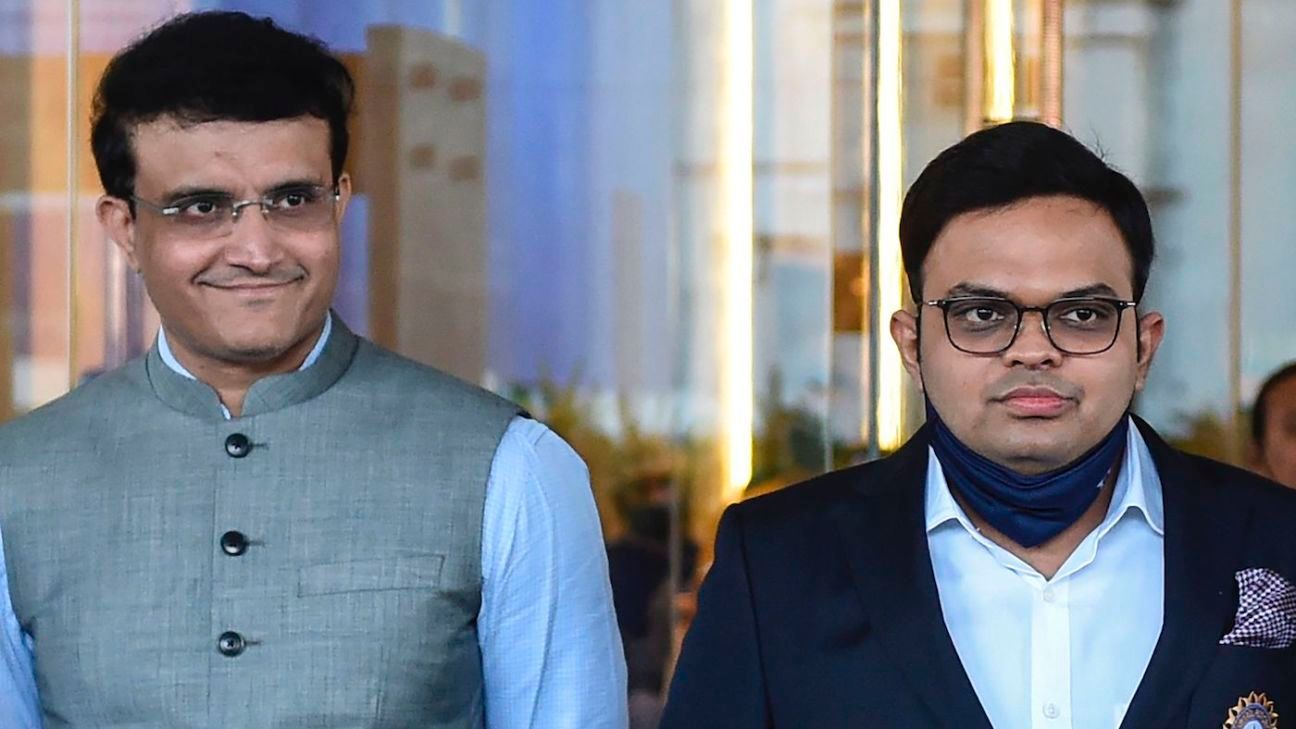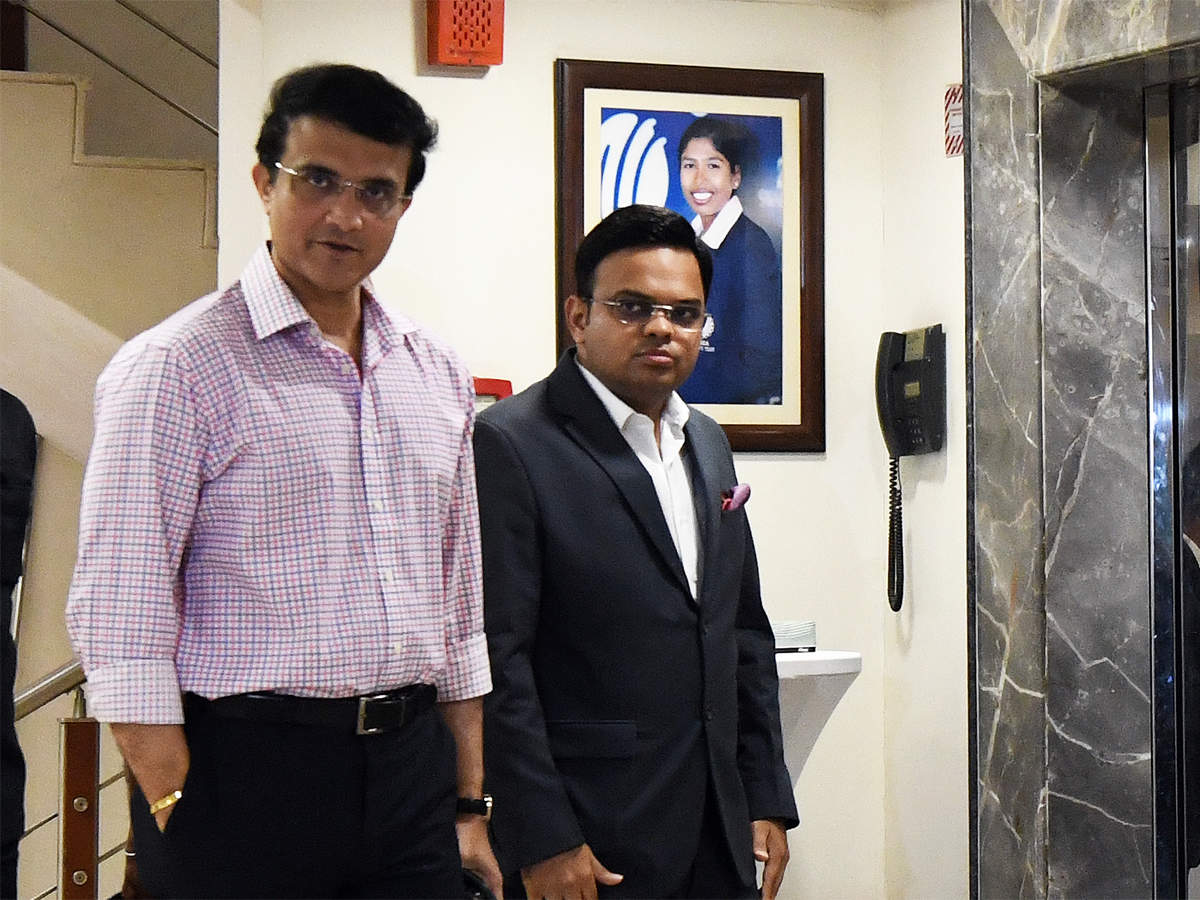Sourav Ganguly, Jay Shah is eligible to helm BCCI till 2025 as Supreme Court agrees to amend the cooling-off period.

The BCCI has suggested doing away with the grace period for its office holders, allowing Ganguly and Shah to remain in their positions as President and Secretary despite having served six years at their respective state cricket associations.
The Supreme Court has relaxed the BCCI constitution’s cooling-off period rule, allowing the current set of office-bearers, led by board president Sourav Ganguly and secretary Jay Shah, to run for re-election until 2025. Justices DY Chandrachud and Hima Kohli’s two-judge panel issued orders to that effect on Wednesday – the formal judgment has not yet been made public – modifying its 2018 decision.
The court agreed to change the current “cooling-off” period rule to permit office holders to hold office for two terms at the state association or BCCI – while removing the clause requiring a fusion of both. Ganguly and Shah would have been ineligible under the current regulations as they had each served one term at the state and BCCI levels. They can now serve another term at the BCCI.
The BCCI adopted a newly drafted constitution in 2018, which was finalized following Justice Chandrachud’s court ruling that an office bearer who has held any post for two consecutive terms (six years) either at a state association or in the BCCI, or a combination of both, shall be ineligible to run for re-election until a three-year cooling-off period has passed. The person is prohibited from acting in any capacity for the BCCI or the state during the cooling-off period.
The BCCI administration approached the court in 2019 seeking several significant amendments to the board’s constitution, which, if approved by the court, would roll back the sweeping reforms passed by the court in 2016 based on the guidance of the RM Lodha Committee. The BCCI wanted to change the cooling-off period for the board’s office bearers, change the disqualification criteria, give the BCCI secretary unprecedented powers, and prevent the court from having any say if the board wanted to change the constitution.

The BCCI stated in its 2019 petition that the existing cooling-off period was a “restriction” that was “proving to be a big blow to selecting talented and experienced hands.” According to the BCCI, the cooling-off period can be used only after the individual has completed six years of service at either the BCCI or the state association.
It stated that this clause would apply to its two most senior office bearers: the president and secretary. The BCCI stated that the three remaining office bearers – treasurer, joint-secretary, and vice-president – should be allowed to complete the maximum tenure of nine years (three terms), rather than having to take a three-year break after two consecutive terms (six years) in the job.
During the hearing, Justice Chandrachud stated, “The current position is that you are out if you have done one term in the state and one term in the BCCI.” “However, we suggest that you are subject to a three-year cooling-off period if you have served six years at the state level” (at state). There is no cooling-off period if you have not worked at the same level for six years.”
Another “format” the court could “possibly consider,” according to Justice Chandrachud, is “a person can be a member at the state or at the BCCI for no more than two terms one by one.” However, if you have served two consecutive terms of three years at the state and BCCI, there must be a three-year cooling-off period. That is two separate proposals. Three in-state, six in the BCCI, or three in-state, three in the BCCI, with a cooling-off period in between, was our initial proposal.
“Second,” you can immediately perform six in the state and then six in the BCCI because they are competing at different levels, “we’re doing something more liberal.” After finishing two terms in a row at two different levels, take a three-year break.
Justice Chandrachud also stated that once a person had completed six years at one location – state or BCCI – he could not return for three years. And if the person had completed 12 years in a row – six at state and six at BCCI – he could not return for three years.
Justice Chandrachud stated that these were his observations prior to the order being issued by him and Justice Kohli. Both justices agreed that a more “balanced” approach would be preferable.
If the court rules in favor of the current BCCI office bearers, they will be able to serve another three-year term. In October 2019, former India captain Ganguly was chosen to lead the BCCI, and Shah, the son of India Home Minister Amit Shah, as secretary. Arun Dhumal, the brother of former BCCI president Anurag Thakur and the Indian Sports and Youth Affairs Minister, was elected BCCI treasurer, while Jayesh George was appointed joint secretary.

The BCCI is due for new elections, which were originally scheduled for the end of this month but were postponed because the board wanted to wait for the court to rule on the proposed amendments.
A cooling-off period’s primary objective, according to Justice Chandrachud, was to prevent any “vested interests” because “you don’t form a clique with undesirable elements for undesirable purposes.” He claimed that asking the office bearer to take a three-year break if he had served six years through a combination of state and BCCI or only six years at the state or BCCI level was “too stringent.”
While Justice Chandrachud had “highest respect” for the RM Lodha Committee, which had originally recommended a three-year cooling-off period after every single three-year term for an office bearer or administrator, he felt it was important to remember that the court was “regulating affairs” as an autonomous body and that it was important to give BCCI “sufficient” freedom “as long as they are not overcoming the purpose” of the judgement.
“The goal of the (court) is to prevent unfair monopolies in cricket or any other sports organization.” You must strike a balance between two requirements: continuity and avoidance of undesirable affiliations. We say you can’t have more than two terms at one level rather than having two terms at two different levels (BCCI and state).
So far, the BCCI has made three significant moves during the Sourav Ganguly-Jay Shah era.
Sourav Ganguly and Jay Shah took over the BCCI in 2019, after the Supreme Court-appointed Committee of Administrators ended their 33-month reign in a tumultuous manner, to say the least. With their tenure now extended, here are the three most important decisions they made.
On September 14, the Supreme Court approved the renewed amendments proposed by the Board of Control for Cricket in India, paving the way for the current committee to be extended for another three years. Thus, Sourav Ganguly will remain as BCCI President, while Jay Shah will continue to serve as the apex body of Indian cricket’s secretary.
Sourav Ganguly and Jay Shah took over the BCCI in 2019, after the Supreme Court-appointed Committee of Administrators ended their 33-month reign in a tumultuous manner, to say the least.

They were hired for just nine months, but their tenure was extended due to COVID-19 because elections could not be held, and they are now set to continue their tenure.
Here are the three most important decisions made by the BCCI during Sourav Ganguly and Jay Shah’s nearly three-year reign.
1) Organizing India’s first-ever day-night Test
Australia and New Zealand played the first day-night Test match under lights, with a pink ball, in the game’s history in Adelaide in 2015. This was a crucial advancement in the development of cricket, as it was an attempt to pique the interest of more spectators in the game’s longest format.
India, on the other hand, had not played a single such Test match in a long time. The first pink ball Test match for India was organized by Sourav Ganguly against Bangladesh at Eden Gardens on November 19, 2019, just a month and a half after being appointed President.
The BCCI made it even more special by inviting West Bengal Chief Minister Mamata Banerjee and Bangladesh Prime Minister Sheikh Hasina to grace the event and advance bilateral relations.
The event was a success, as the Kolkata stadium was packed throughout the game as India defeated Bangladesh by an innings and 46 runs.
2) Performing two IPLs in the pandemic
The 2020 season of the IPL was intended to be the inaugural contest under the new BCCI leadership of Sourav Ganguly and Jay Shah, which was supposed to begin on March 29, 2020. However, the COVID-19 pandemic struck, and the country was placed on lockdown. While many thought that the IPL 2020 was over, the BCCI had other plans.
They pushed back the tournament to November 8 because it was being held in the UAE, a country where the situation was far less dire than in India. The BCCI was able to hold a successful tournament by using proper bio bubbles and restrictions.

The IPL returned to India in 2021, with games beginning on April 9. The tournament was still going on, but it came under scrutiny after several foreign players dropped out and many teams were infected with the Coronavirus, as the country entered the much more lethal second wave of the pandemic. The tournament was called off after 29 of the 60 games were completed.
However, it resumed on September 19, after the BCCI decided to move it back to the UAE, and this time 50% of the crowd was allowed inside the stadiums.
3) Raising the pay of domestic players
The biggest and most important decision made by the BCCI under Jay Shah and Sourav Ganguly to date is the decision to significantly increase the salaries of domestic players beginning with the 2021-22 season. In fact, the board decided to compensate players who participated in the 2019-20 season for the 2020-21 season, which was canceled due to the COVID-19 pandemic.
Previously, players who made the XI of a particular domestic team were paid Rs 35,000 per day, while reserve players were paid Rs 17,500 in senior tournaments.
The BCCI then decided to implement three slabs based on the age of domestic players. Senior players with up to 20 games played will now be paid Rs 40,000 per day, while reserves will be paid Rs 20,000 per day. Those in the starting eleven who have appeared in 21 to 40 matches will now be paid Rs 50,000, with the reserves receiving Rs 25,000. Players who have played in more than 40 matches will be paid Rs 60,000 per game, while reserves will be paid Rs 30,000.
One observer praised the decision, saying it would allow professional cricketers to devote all of their time to playing the game while also providing them with a fair wage.




